Quick Summary
Click here for Price and Turnaround Time
Note: This test was updated January 2022 to reflect new research findings. The new test examines two separate regions that affect pigmentation pattern in the dog and better explains the coat color patterns determined by this gene. For more information, see the Additional Details section below.
Phenotype: The allelic series at the A locus controls for pigment pattern ranging in phenotype from a mostly yellow dog, to a yellow dog with a black back, to a completely black dog (and everything in between). See detailed descriptions of each phenotypic pattern below.
Mode of Inheritance: Allelic series with some codominance, ASIPDY > ASIPSY > ASIPAG > ASIPBS > ASIPBB1, BB2, BB3 > ASIPa
Haplotype Combinations:
ASIPDY = Dominant Yellow
ASIPSY = Shaded Yellow
ASIPAG = Agouti
ASIPBS = Black Saddle
ASIPBB1= Black Back, diplotype 1
ASIPBB2 = Black Back, diplotype 2
ASIPBB3 = Black Back, diplotype 3
ASIPa = recessive black
Breeds appropriate for testing: Many breeds
Results of this test can be submitted to the OFA (Orthopedic Foundation for Animals)
Explanation of Results:
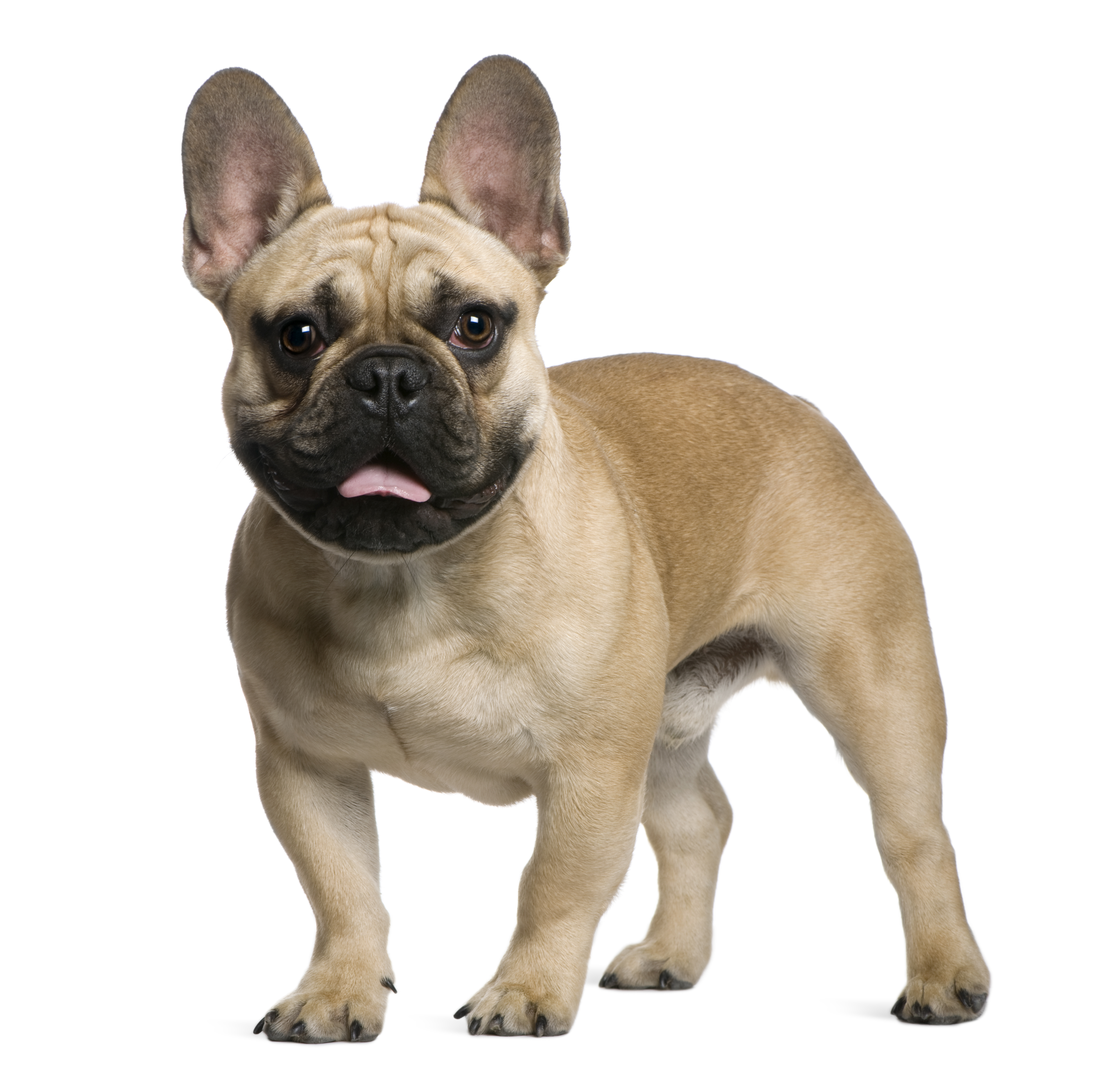
Dominant Yellow (DY): Dogs with ASIPDY genotype will have a clear yellow base coat (yellow to red with minimal to no black-tipped hairs) in the absence of Dominant Black (K locus).
• Dogs with ASIPDY/ASIPDY genotype will transmit this Dominant Yellow variant to all of their offspring.
• Dogs with ASIPDY/ASIPSY, ASIPDY/ASIPAG, ASIPDY/ASIPBS, ASIPDY/ASIPBB1,BB2,BB3, or ASIPDY/ASIPa genotype will be Dominant Yellow and are carriers of other ASIP haplotype combinations. They will transmit this Dominant Yellow variant to 50% of their offspring.
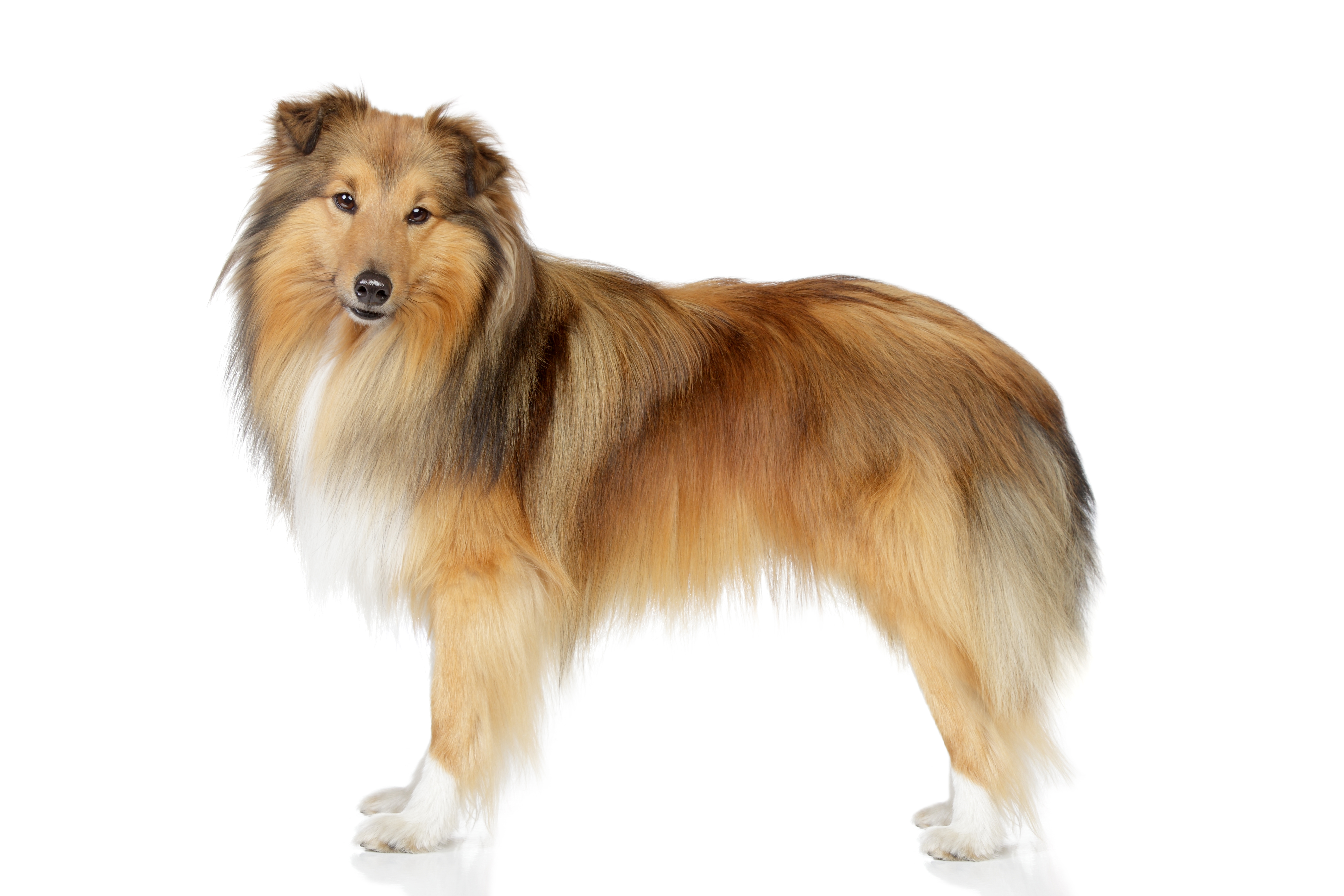
Shaded Yellow (SY): Dogs with ASIPSY/ASIPSY, ASIPSY/ASIPAG, ASIPSY/ASIPBS, ASIPSY/ASIPBB1,BB2,BB3, or ASIPSY/ASIPa genotype will have a shaded yellow base coat (yellow to red with some dorsal black-tipped hairs) in the absence of Dominant Black (K locus).
• Dogs with ASIPSY/ASIPSY genotype will transmit this Shaded Yellow variant to all of their offspring.
• Dogs with ASIPSY/ASIPAG, ASIPSY/ASIPBS, ASIPSY/ASIPBB1, ASIPSY/ASIPBB2, ASIPSY/ASIPBB3, or ASIPSY/ASIPa genotype will be Shaded Yellow and are carriers of other ASIP haplotype combinations. They will transmit this Shaded Yellow variant to 50% of their offspring.
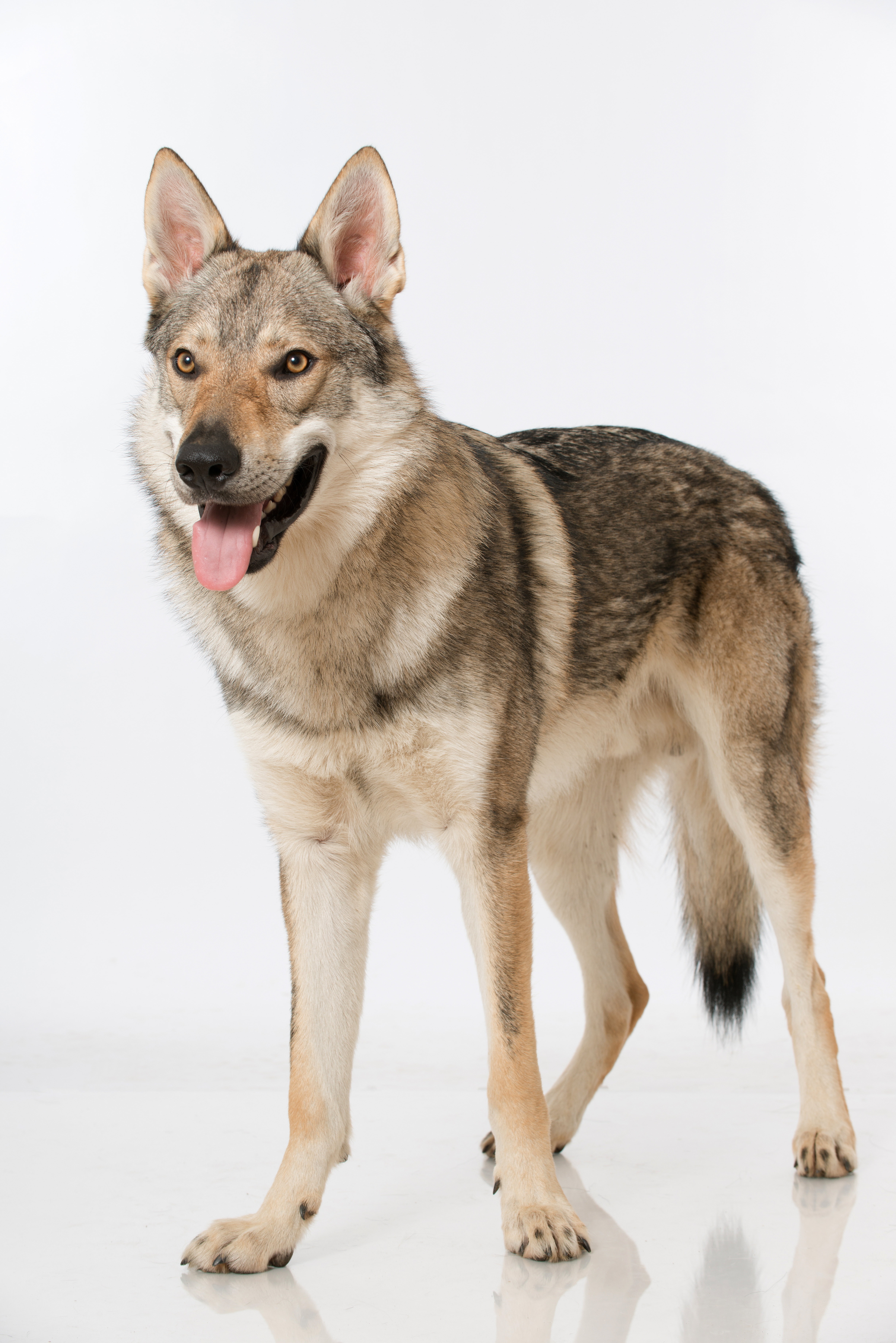
Agouti (AG): Dogs with a ASIPAG/ASIPAG, ASIPAG/ASIPBS, ASIPAG/ASIPBB1,BB2,BB3, or ASIPAG/ASIPagenotype will have an Agouti base coat (banded hairs of yellow and black) in the absence of Dominant Black (K locus ).
• Dogs with ASIPAG/ASIPAG genotype will transmit this Agouti variant to all of their offspring.
• Dogs with ASIPAG/ASIPBS, ASIPAG/ASIPBB1, ASIPAG/ASIPBB2, ASIPAG/ASIPBB3, or ASIPAG/ASIPa genotype will be Agouti and are carriers of other ASIP haplotype combinations. They will transmit this Agouti variant to 50% of their offspring.
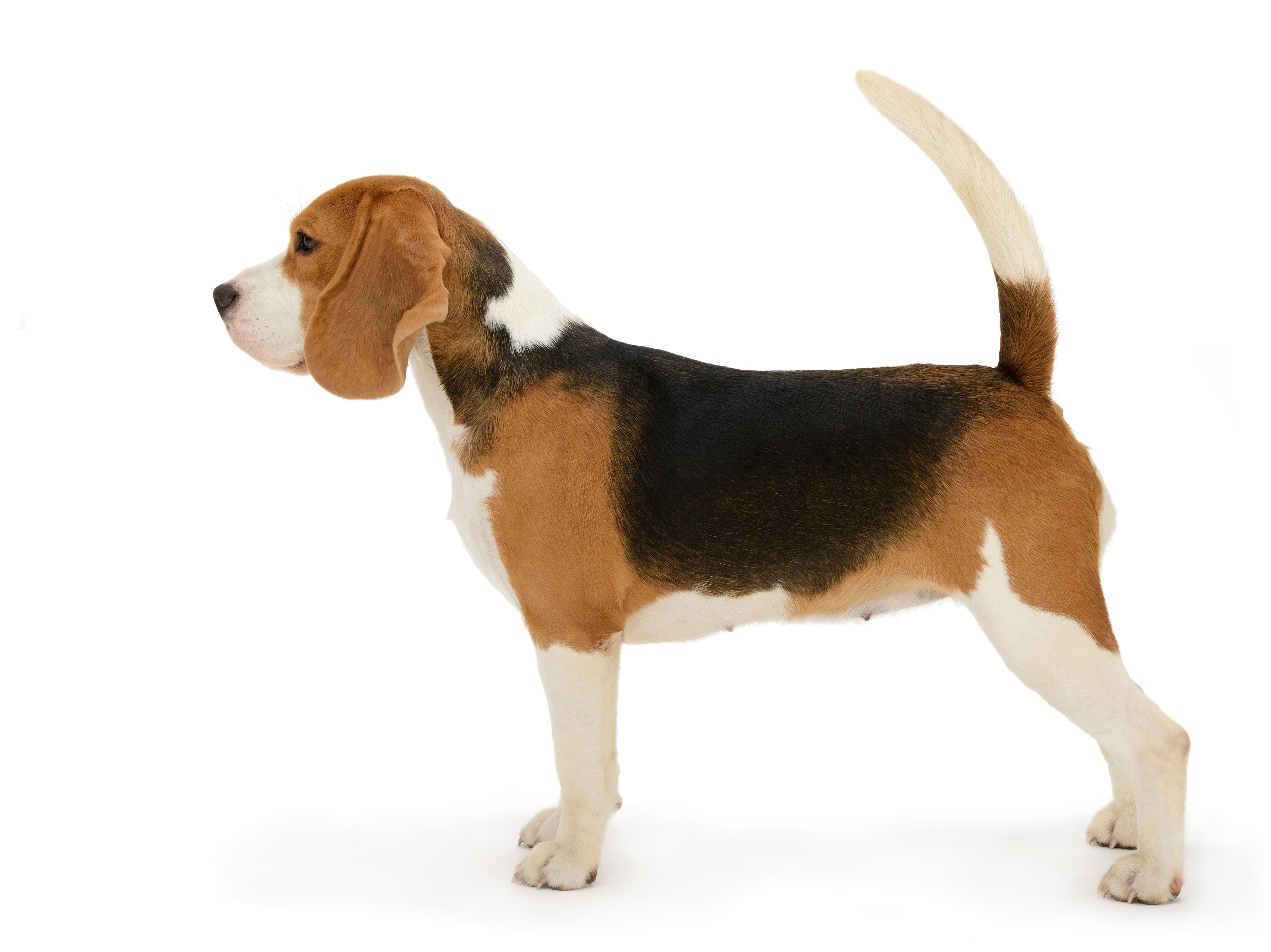
Black Saddle (BS): Dogs with a ASIPBS/ASIPBS, ASIPBS/ASIPBB1,BB2,BB3, or ASIPBS/ASIPa genotype will have a black saddle (black-pigmented hair primarily restricted to the dorsal region with red in the rest of the coat) in the absence of Dominant Black (K locus ).
• Dogs with ASIPBS/ASIPBS genotype will transmit this Black Saddle variant to all of their offspring.
• Dogs with ASIPBS/ASIPBB1,BB2,BB3genotype will have Black Saddle and are carriers of other ASIP haplotype combinations. They will transmit this Black Saddle variant to 50% of their offspring.
• Dogs with ASIPBS/ASIPa genotype will have Black Saddle and are carriers of Recessive Black. They will transmit this Black Saddle variant to 50% of their offspring.
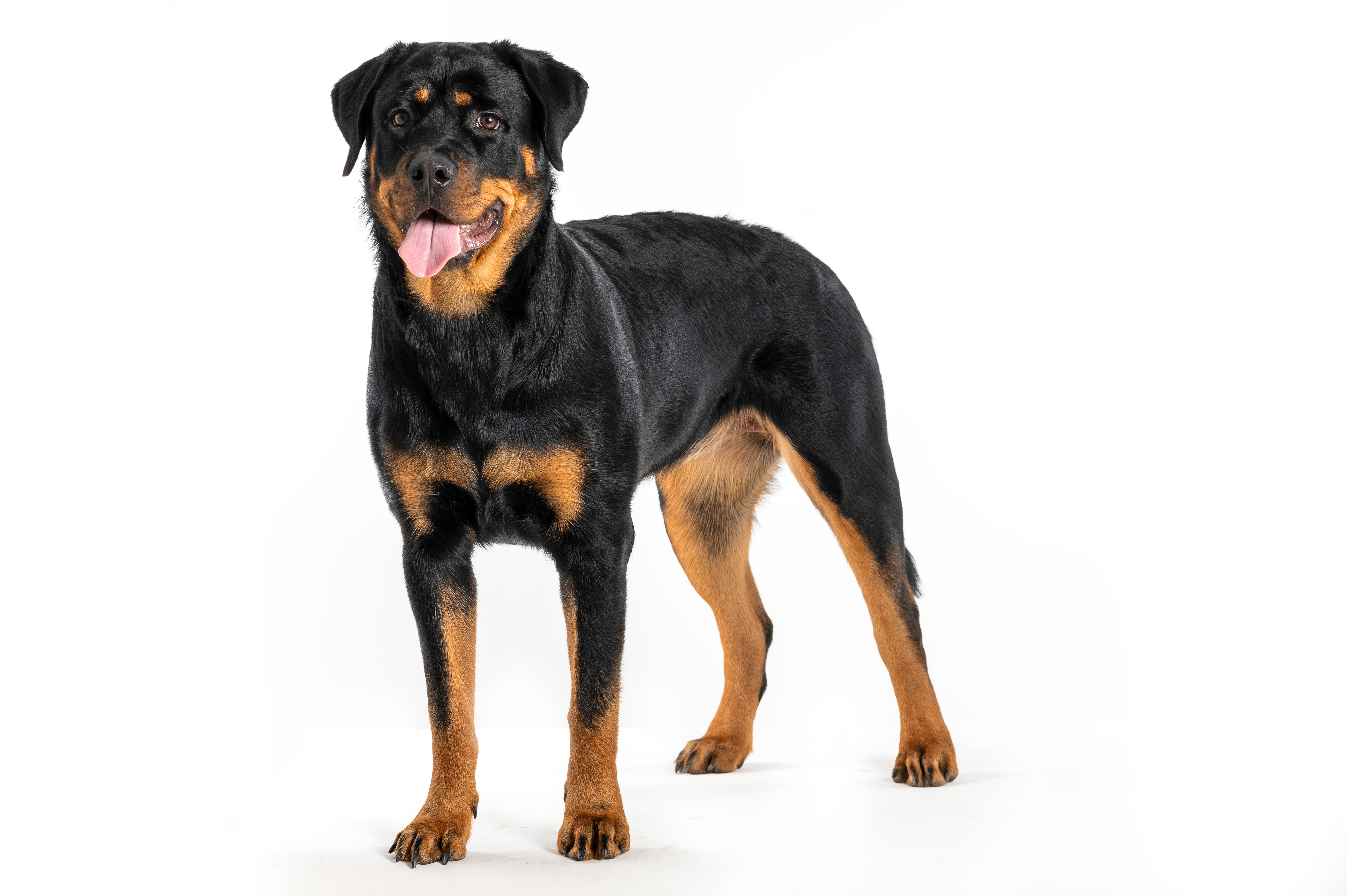
Black Back: Dogs with any combination of the three variants associated with Black Back (ASIPBB1,BB2,BB3/ASIPBB1,BB2,BB3), or ASIPBB1,BB2,BB3/ASIPa genotype will have a Black Back or black-and-tan base coat (black dorsal hairs and tan hair on cheeks, eyebrows, and undersides) in the absence of Dominant Black (K locus).
• Dogs with any ASIPBB1,BB2,BB3/ASIPBB1,BB2,BB3 combination genotype will be Black Back and transmit a Black Back variant to all of their offspring.
• Dogs with ASIPBB1,BB2,BB3/ASIPa genotype will be Black Back and are carriers of Recessive Black. They will transmit this Black Back variant to 50% of their offspring.
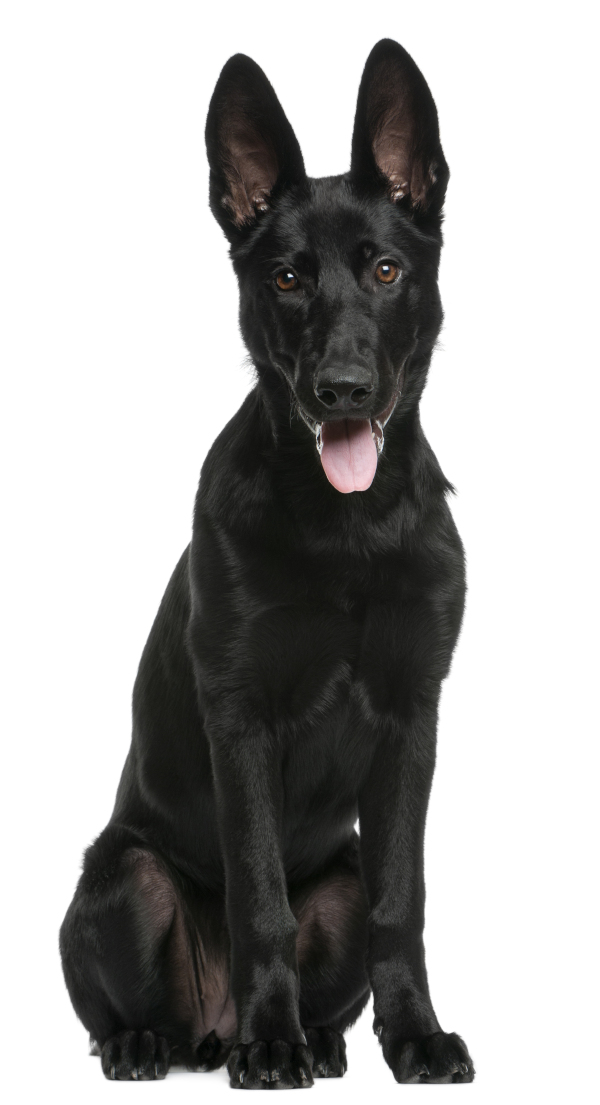
Recessive Black (a): Dogs with ASIPa/ASIPa genotype will have an all-black base coat; overall appearance of the dog also depends on interactions with other genes including those at the E Locus (MC1R). They will transmit this Recessive Black variant to all of their offspring.
In the patterns above with red/yellow pigment the difference in shade (shade of phaeomelanin) is controlled by other genes, such as intensity dilution (MFSD12), the dilute gene (MLPH) and KITLG. All of these patterns can also be seen in animals that have brown eumelanin in place of black eumelanin caused by variation at the Brown locus (TYRP1). Final pigmentation and pattern is also dependent on genotype at the MC1R locus.
Dog Coat Color - Basic Panel (All breeds)
$100 per animal
Additional coat colors $15 per test
Dog Coat Color - French Bulldog Panel
$105 per animal
Additional coat colors $15 per test
Dog Coat Color - Bulldog Panel
$80 per animal
Additional coat colors $15 per test
Dog Coat Color - Great Dane Panel
$80 per animal
Additional coat colors $15 per test
Dog Coat Color and Type - Havanese Panel
$115 per animal
Additional coat colors $15 per test
Sample Collection
Dog DNA tests are carried out using cells brushed from your dog's cheeks and gums. The preferred cytology brushes are sent to you by mail, or you may provide your own brushes. For accepted alternative brushes, click here
We recommend waiting until puppies are at least three weeks old before testing.

Step-By-Step:
- Make sure the dog has not had anything to eat or drink for at least 1 hour prior to collecting sample.
- When swabbing puppies, isolate each puppy from the mother, littermates and any shared toys for 1 hour prior to swabbing. Puppies should not have nursed or eaten for 1 hour prior to collecting sample.
- If collecting samples from more than one dog, make sure to sample one dog at a time and wash your hands before swabbing another dog.
- Label brush sleeve with name or ID of dog to be sampled.
- Open brush sleeve by arrow and remove one brush by its handle.
- Place bristle head between the dog’s gums and cheek and press lightly on the outside of the cheek while rubbing or rotating the brush back and forth for 15 seconds.
- Wave the brush in the air for 20 seconds to air dry.
- Insert brush back into sleeve.
- Repeat steps 5 - 8 for each unused brush in sleeve on a fresh area of cheek and gums. Make sure to use and return all brushes sent by the VGL. In most cases, it will be 3 brushes per dog. If using interdental gum brushes, please note that the VGL requires 4 brushes per dog and only moderate or wide interdental gum brushes are accepted.
- Do not seal brushes in sleeve.
- Place all samples in an envelope and return to the address provided.
ATTENTION:
- Do not collect saliva/drool – the key to obtaining a good sample is getting cheek cells on the swab
- Do not rub swab on the dog’s tongue or teeth – this will result in poor quality sample
- Do not collect a sample from a puppy that has recently nursed – the mother’s genetic material can rub off on the puppy’s mouth and contaminate the sample
The Agouti Signaling Protein (ASIP) gene, also referred to as the A locus or the ASIP locus, controls where and when eumelanin (i.e. black or brown pigment, or their respective dilutions) and phaeomelanin (i.e. red or yellow pigment, or their respective dilutions) is produced in the coat of most mammals, including dogs. The Agouti protein does this by interacting with the melanocortin 1 receptor (MC1R) to cause a switch in pigment deposition, from the dark eumelanin pigment to the lighter phaeomelanin pigment, in the hair shaft at different stages of hair growth.
The exact role of ASIP in producing the numerous coat color patterns observed in dogs was challenging for geneticists to unravel partly due to the complexity of canine coat color patterns and the difficulty in identifying causal relationships between genetic variations and coat pattern phenotypes. Dog coat color is further complicated by the interaction of other genes, such as the Dominant Black gene/K Locus (also known as the Beta-Defensin 103 gene), which only allows for black pigment to be produced. Additionally, variants at other genetic loci, such as the melanistic mask allele at the MC1R locus, can hide some of the patterns produced by ASIP, hindering visual assessment of the ASIP phenotype in some dogs.
Until January 31, 2022, the VGL reported four Agouti variants as ay= Fawn/sable, aw = Wild sable, at = Black-and-tan, and a = Recessive black. However, these allele designations failed to explain all the coat color phenotypes being controlled by this gene.
Research by Dr. Danika Bannasch and colleagues has unraveled more of the complexity of dog coat color and allowed for a new Agouti test to be developed. This new system better explains what we now know about the genetics of coat pattern variation in dogs and the new nomenclature encompasses three more ASIP-based coat color patterns that did not have fully resolved genetic bases until now.
The study determined five main Agouti-based dog coat color patterns (phenotypes) arising from the combination of variants (called haplotypes) in two non-coding regions of the ASIP gene called promoter regions. These regions are known as the ventral promoter (VP) and the hair cycle promoter (HCP). The VP and HCP regions work independently from each other to regulate expression of the Agouti gene. Combinations of VP and HCP haplotypes lead to either a Dominant Yellow, Shaded Yellow, Agouti, Black Saddle or Black Back coat color pattern in dogs. Recessive Black, the sixth ASIP color pattern, is controlled by a single nucleotide variant in a different region of the ASIP gene (a coding region) that is often seen on a Black Back VP-HCP haplotype background. The specific variants comprising each VP and HCP haplotype can be found in the table below (Table 1).
Table 1: Specific variants characterizing each VP and HCP haplotype*, as well as corresponding ASIP combination haplotypes and resulting Agouti-based coat color patterns, are listed below. Variants comprising each VP and HCP haplotype are located in non-coding regions of the ASIP gene (i.e. promoter regions). The variant determining a Recessive Black phenotype is located within the coding region of ASIP and is typically seen on a VP2+HCP3 background.
|
Phenotype Name |
Ventral Promoter (VP) |
VP Haplotype Name |
Hair Cycle Promoter (HCP) |
HCP Haplotype Name |
ASIP Combination Haplotype |
|
Dominant Yellow |
SINE C2A1_CF insertion, 64 base pair poly A insertion |
VP1 |
SINE C2A1_CF insertion, 24 base pair insertion |
HCP1 |
ASIPDY |
|
Shaded Yellow |
wildtype |
VP2 |
SINE C2A1_CF insertion, 24 base pair insertion |
HCP1 |
ASIPSY |
|
Agouti |
wildtype |
VP2 |
wildtype |
HCP2 |
ASIPAG |
|
Black Saddle |
SINE C2A1_CF insertion, 64 base pair poly A insertion |
VP1 |
SINE C1A_CF partial deletion, SINE C2A1-CF-SINE C2A1-CF insertion , 1403 base pair deletion |
HCP4 |
ASIPBS |
|
Black Back, diplotype 1 |
wildtype |
VP2 |
SINE C1A_CF plus 45 base pair deletion, SINE C2A1-CF-SINE C2A1-CF insertion |
HCP3 |
ASIPBB1 |
|
Black Back, diplotype 2 |
wildtype |
VP2 |
SINE C1A_CF partial deletion, SINE C2A1-CF-SINE C2A1-CF insertion , 1403 base pair deletion |
HCP4 |
ASIPBB2 |
|
Black Back, diplotype 3 |
wildtype |
VP2 |
100-base pair A rich insertion within the HCP exon 1 |
HCP5 |
ASIPBB3 |
| Recessive Black |
Single nucleotide change in the coding region of ASIP (typically seen on a VP2 + HCP3 background**) |
ASIPa | |||
* Agouti research is ongoing and additional variation beyond the resolution of this test may exist
** The Recessive Black phenotype is thought to be solely dependent on the single nucleotide change located in the coding region of ASIP. To date, this variant has only been seen on a VP2+HCP3 background.
Figure 1 below lists the ASIP haplotype combinations that the VGL currently tests for as well as their corresponding dog coat color patterns. To help understand how these new ASIP haplotype combinations relate to the old Agouti marker alleles (i.e. now referred to as Legacy Agouti), we have also included the old designation in the table. As illustrated below, some coat patterns were genetically indistinguishable with the old test.
Note: The illustrations below portray examples of adult patterns. Puppy colors exhibit more eumelanin and tend to look darker. For example, in puppies the Black Saddle coloration looks like Black Back and Shaded Yellow can look very similar to Agouti.
Figure 1: Phenotype classification and corresponding ASIP haplotype combinations. Legacy Agouti alleles included for reference
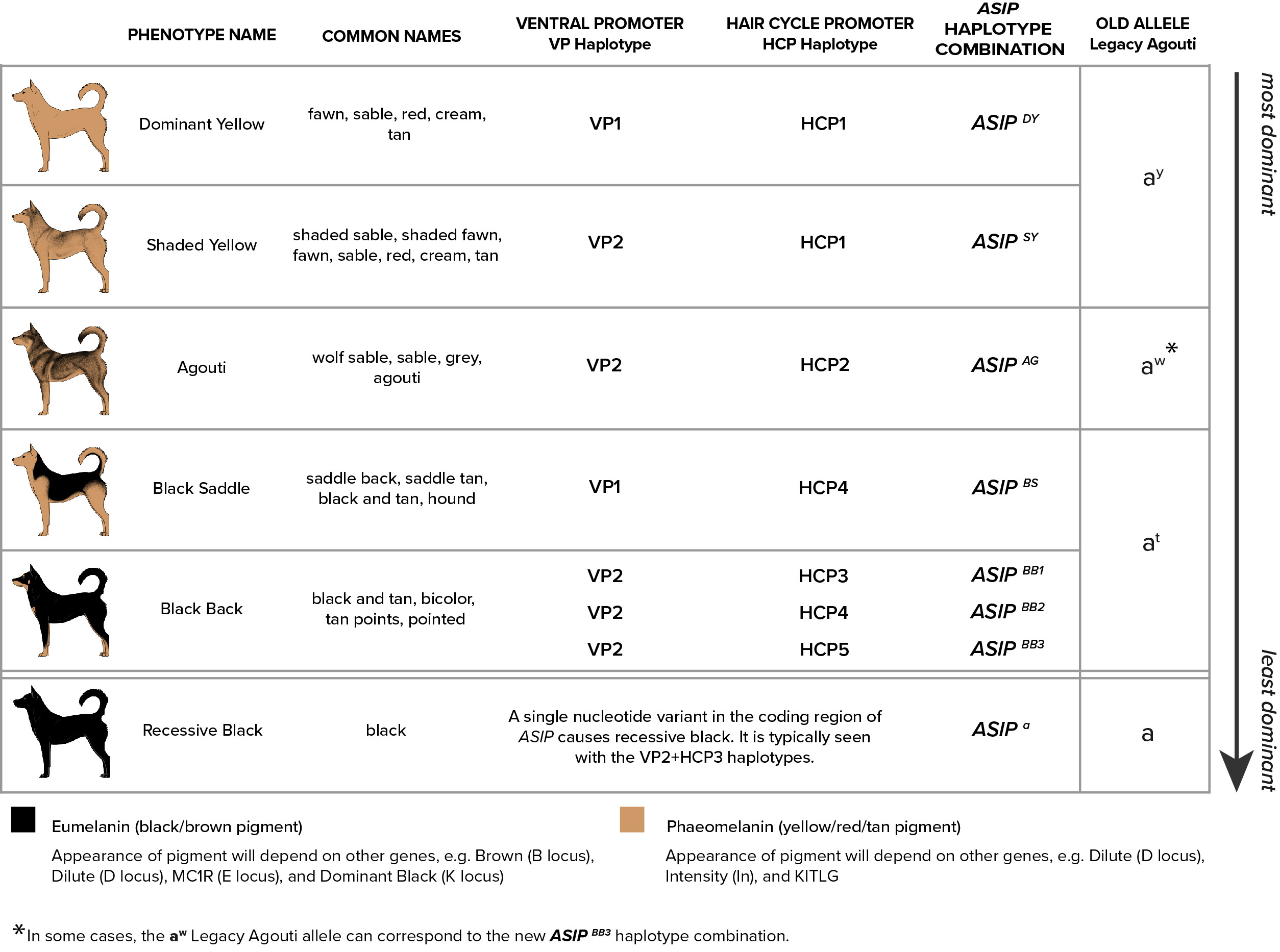
Many dog breeds carry 2 to 4 of these ASIP haplotype combinations and it may be advantageous for breeders to predict the possible colors of offspring resulting from specific crosses. The ASIP test is also useful to help determine the color of dogs that have white patterns that may obscure the distribution of the colored pigment. Also, since puppy patterns aren’t always indicative of adult coats, testing for the agouti gene can help determine adult coat pattern.
Testing for ASIP allows breeders and owners to determine the ASIP haplotype combinations present in their dogs. This test will help determine possible coat color outcomes from specific crosses.



